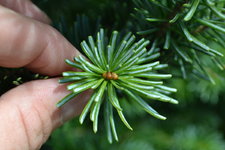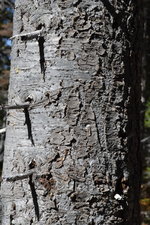Ok, absolutely not sure about either bark nor needle crush tests. These are very subjective imho.
There are two reported sub species in Western North America and the possibly of a Abies Lasiocarpa x Abies Procera cross… plus a scientific recognition of innumerable variations of Abies lasiocarpa in the field in different areas and different elevations… mot interlacing. In other words these variations occurred within their own local population. However, an Abies lasiocarpa/Abies Amabilis cross has never been found att.
Perhaps this excerpt below will help shed some more light on your situation August.
Cheers
DSD sends
Taxonomic notes
There are three distinct types of Abies lasiocarpa, which are here described as varieties:
A. lasiocarpa var. lasiocarpa, the northern subalpine fir, described from Mount Hood, Oregon.
A. lasiocarpa var. arizonica (Merriam) Lemmon, the corkbark fir, native to the southern Rocky Mountains.
A. lasiocarpa var. bifolia Eckenwalder 2009, the western subalpine fir, native to much of the interior of western North America.
Although it is so named in the Flora of North America, most conifer biologists have chosen not to recognize var. bifolia as a separate species, because only very minor characters distinguish it from typical A. lasiocarpa. The variety is said to be distinct from var. lasiocarpa in chemical tests on wood, lack of crystals in the ray parenchyma, lack of lasiocarpenonol, and distinct terpene patterns. Var. bifolia also tends to have slightly shorter and fewer prominently notched leaves than var. lasiocarpa. The two are separated by the color of their periderm and by the shape of their basal bud scales (Hunt 1993). My experience, however, is that these characters are continuously varying and they can be found throughout the range in which I have encountered the species, which extends from southern British Columbia into Oregon and east to Montana, Wyoming, and Colorado. Adams et al. (2011) examined essential oils and DNA sequences in populations presumably representing the three varieties (Olympia Mountains of Washington, eastern Rocky Mountain Front in Montana, Wasatch Mountains in Utah, San Francisco Peaks in Arizona) and found only very small DNA differences but consistent essential oil differences, consistent with the notion that varietal distinctions are a function of adaptation to different climates. I doubt that even an expert can consistently distinguish vars. lasiocarpa and bifolia based solely on morphological characters. Distinguishing between var. bifolia and var. arizonica is also ambiguous, and is primarily based on the thickened, 'corky' bark of var. arizonica that may also be dark grey and deeply furrowed.
In north central Alberta, var. bifolia introgresses with A. balsamea (Hunt and von Rudloff 1974, Moss 1953, both cited by Hunt 1993). At the southern end of its range, var. lasiocarpa possibly hybridizes with A. procera, but the taxa are normally separated by habitat and elevation. Var. lasiocarpa shares with A. procera a red periderm, crystals in the ray parenchyma, and reflexed tips of the bracts, features not shared with var. bifolia (Hunt 1993). A. lasiocarpa (var. lasiocarpa and var. bifolia) and A. amabilis, although sympatric over a wide area, are separated by many morphologic features, and no hybrids have been found (Hunt 1993).
Unique populations of var. lasiocarpa from coastal Alaska are found at lower elevations (0-900 m) and appear to be isolated with no reported introgression between them and the coastal mountain populations (Heusser 1954, Harris 1965). The population on the Prince of Wales Island has distinct terpene patterns and warrants further study to clarify its separation from neighboring populations (Hunt 1993).
Synonymy:
For var. lasiocarpa, Pinus lasiocarpa Hooker 1838.
For var. bifolia, Abies bifolia A. Murray, Abies subalpina Engelmann, and A. lasiocarpa subsp. bifolia (A. Murray) Silba 2008.
Citation:
https://www.conifers.org/pi/Abies_lasiocarpa.php IMG_3353.jpg114.9 KB · Views: 58
IMG_3353.jpg114.9 KB · Views: 58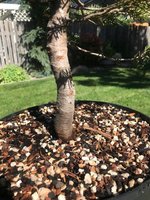 IMG_3354.jpg100.1 KB · Views: 45
IMG_3354.jpg100.1 KB · Views: 45 IMG_3355.jpg89.5 KB · Views: 38
IMG_3355.jpg89.5 KB · Views: 38 IMG_3356.jpg110.7 KB · Views: 37
IMG_3356.jpg110.7 KB · Views: 37 IMG_3357.jpg103.9 KB · Views: 35
IMG_3357.jpg103.9 KB · Views: 35 IMG_3358.jpg117.3 KB · Views: 31
IMG_3358.jpg117.3 KB · Views: 31 IMG_3359.jpg110 KB · Views: 31
IMG_3359.jpg110 KB · Views: 31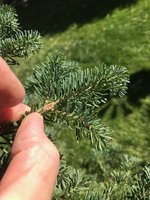 IMG_3360.jpg102.2 KB · Views: 27
IMG_3360.jpg102.2 KB · Views: 27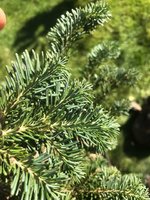 IMG_3361.jpg93.8 KB · Views: 28
IMG_3361.jpg93.8 KB · Views: 28 IMG_3362.jpg110.8 KB · Views: 42
IMG_3362.jpg110.8 KB · Views: 42













